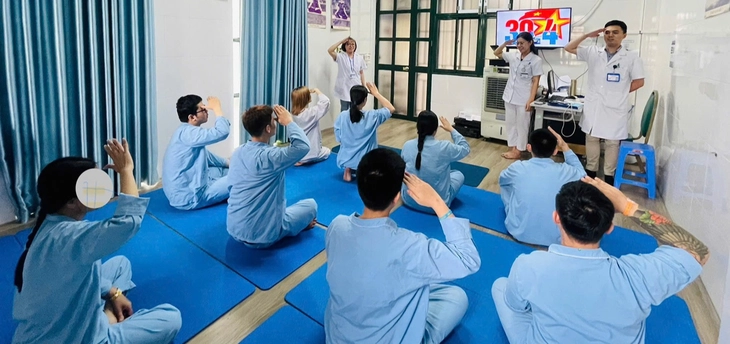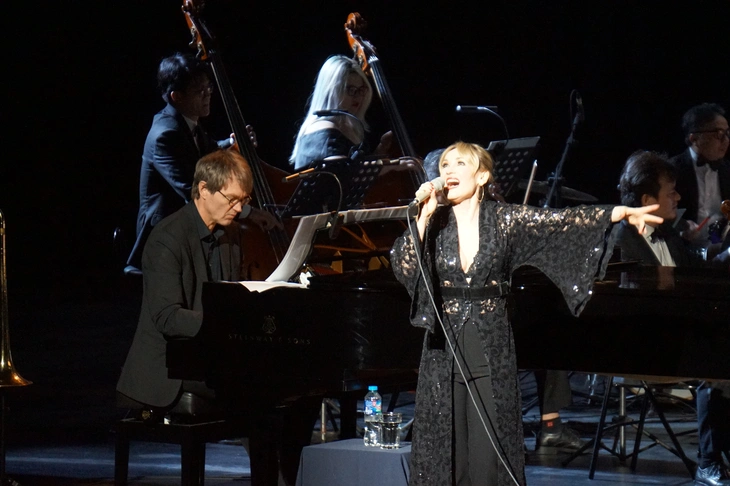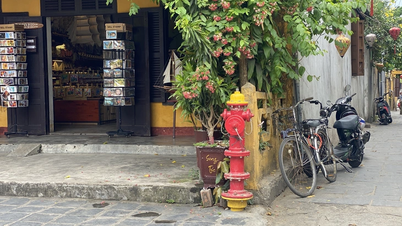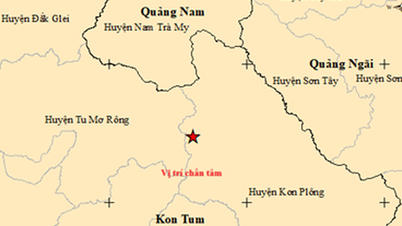
Music therapy for "healing" at the Institute of Mental Health - Photo: BVCC
Music helps to "awaken" emotions that have been dormant and suppressed for a long time in the past. Dr. Thanh Huong shared: People with depression often live a closed, withdrawn life, prefer quiet activities, lose motivation, and have reduced interest.
The main emotional states are: sadness, boredom, disappointment, self-pity… sometimes there is even emptiness in the state of emotional paralysis. They may not cry, not laugh, and may not even realize whether they are sad or happy.
Music, with its variety of melodies, rhythms, and lyrics, helps to rekindle feelings that seem lost. "A sad song can help them identify their pain. A bright melody can rekindle hope. That is the first step to healing," Dr. Huong explained.
Unlike cognitive therapy, behavioral therapy, group psychology or family therapy... which require patients to share verbally, concisely express their frustrations, self-pity, and thoughts about events and phenomena around them, music therapy allows them to express their emotions in the most natural way.
They don't need to speak, just hum the lyrics to the melody and rhythm of the song. They sing with all their feelings and emotions from their hearts. They play simple instruments like drums, bells, guitars.
…; Compose melodies or short lyrics...
Through these very personal expressions, patients can express their deepest feelings, which can be their wishes, ambitions, beliefs and hopes. "These emotions are not easily expressed in words, but can be released through a piece of music," a music therapist shared.
Why can music heal?
Rhythm is the "medicine" for the nervous system. Scientific research has shown that: Heart rate and breathing tend to synchronize with the rhythm of music; Slow music (60-80 beats/minute) helps reduce cortisol, stabilize blood pressure and cheerful melodies stimulate the production of endorphins - the happy hormone.
Various musical activities, such as listening to music, singing, and playing musical instruments, evoke unique brain responses influenced by individual musical characteristics and attributes.
When listening to music, multiple brain regions associated with emotion, memory, and creativity become active. This is especially relevant for people with depression, who often have reduced function in these brain regions.
Rhythm activates the "emotional pathways" in the brain. Listening to music improves cognitive functions such as memory, concentration, and enhances behavior.
Singing is the act of producing music with the voice, usually to a particular melody and lyrics. It is performed through "singing a song" to improve speech fluency, executive function, and episodic memory.
Structural changes such as increased white matter integrity and enhanced auditory-motor integration highlight the potential of singing to stimulate neural plasticity.
Group of patients with disorders:
Depression, dementia, autism, and difficulties with verbal and nonverbal communication often have a variety of problems involving emotions, cognition, and behavior.
Their participation in music therapy helps them improve the above difficulties. Ms. Thanh Huong said: "Group music therapy helps patients: Feel the harmony when singing a song together, playing music games, humming the lyrics, melodies, and rhythms in music, helping them regain a sense of peace.
It can be said that music eases the pain, releases the frustration and discomfort from the patient's illness.

"Music does not replace medicine but makes medicine more effective" for those who need healing - Illustration: T.DIEU
Therapeutic Journey: From Silence to Voice
At Bach Mai Mental Health Institute, each patient has their own "unique music" on their recovery journey. That journey includes the following stages:
Phase 1: Listening
- The therapist chooses music that reflects the patient's current mood.
- Don't rush to happy music, but let them be truly understood.
Phase 2: Get in tune
- The patient begins to participate by tapping the rhythm and humming to the melody.
- Simple instruments like tambourines are used to increase interaction.
Phase 3: Speak Up
- Choose your favorite song to sing.
- Composing short lyrics about hope, about the little things that make them feel warm.
"We don't force them to be happy immediately. What's important is that they dare to face and express their true feelings," Ms. Huong emphasized.
Messages from the healers
Message 1: "Music does not replace medicine but makes medicine more effective"
Music therapy is not a replacement but a companion to other treatments. This combination provides comprehensive results:
- Medicines that help balance brain biochemistry.
- Music heals psychological trauma.
Message 2: "Give yourself the right to hear and feel"
Many patients share that they have long lost the habit of listening to themselves. Music therapy not only helps them regain their emotions, but also gives them a tool for self-healing:
- Create your own playlist for gloomy days.
- Sing an old song when you feel lonely.
- Use music to relieve stress, create motivation, add faith and hope in life.
In the therapy room, some people cried when they heard a familiar song. Some people burst out laughing when they dared to sing loudly in front of others for the first time. These seemingly ordinary moments were turning points in the journey to escape the darkness of depression.
Source: https://tuoitre.vn/su-dung-am-nhac-chua-lanh-hat-mot-bai-quen-thuoc-khi-buon-ban-se-vui-20250501115406687.htm


![[Photo] Pink ball and table tennis](https://vphoto.vietnam.vn/thumb/1200x675/vietnam/resource/IMAGE/2025/5/26/d9f770bdfda243eca9806ea3d42ab69b)

![[Photo] Official welcoming ceremony for French President Emmanuel Macron and his wife on a state visit to Vietnam](https://vphoto.vietnam.vn/thumb/1200x675/vietnam/resource/IMAGE/2025/5/26/a830702ef72f455e8161b199fcefc24d)
























































































Comment (0)